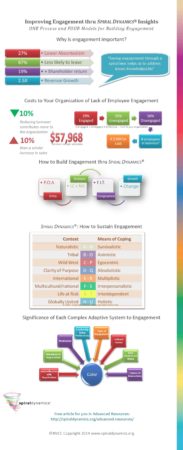Engagement, SD Style…
 Engagement impacts performance and bottom line results profoundly, yet today only 29% of employees are engaged and a mere 10% are highly engaged in most organizations. Any wonder there is such obsession with building and enhancing engagement? If you’re concerned with getting people more involved, then Spiral Dynamics® Programs and Assessments can help you to crack open related secrets of human nature and motivation. There are four unique “spiral” steps to help you with this.
Engagement impacts performance and bottom line results profoundly, yet today only 29% of employees are engaged and a mere 10% are highly engaged in most organizations. Any wonder there is such obsession with building and enhancing engagement? If you’re concerned with getting people more involved, then Spiral Dynamics® Programs and Assessments can help you to crack open related secrets of human nature and motivation. There are four unique “spiral” steps to help you with this.
Step 1: Map the Field
Keep in mind that engagement occurs within a field; you’ve got to get the lay of the psychosocial landscape accurately. Individual leaders navigate a particular context that involves their direct reports, peers, customers and the organizational and competitive environment. Each worker has to negotiate a unique field that brings out their best, worst, or draws only a bit of energy and talent out. Teams operate in a culture where they interact with organizational processes, structures, systems, and messages. Use the Life Conditions model (TPPC) as covered in SDL1 and SDL2 to map the terrain and to track the values, beliefs, key patterns, and both the written and unstated norms in the context you seek to understand.
Step 2: Identify the Engagement Phase
Treat engagement like fuel; it needs topping up regularly. Are you adding, maintaining, or draining engagement? It is likely that you’ll have a mixed bag to work with. Some people will be positively engaged and show it. Others will be but won’t look like it – their fuel gauges are stuck. Others will be disengaged – they’ll need fueling. Still others might once have been engaged only to become passively negatively engaged now – their tanks are low and they are conserving energy. Some might even shift to active negative – depleted and resentful that refueling hasn’t been attempted.
You need to identify the phase(s) of engagement, and institute a variety of approaches to match them for individuals, teams, departments, groups, and leaders. Unfortunately, a one-size-fits-all approach is unlikely to work. We’ve put an Engagement Matrix for you in the article, Engagement: A Spiral Dynamics Perspective. (Go to Advanced Resources and register for free). In it we cover four forms of engagement with cases to elaborate on each.
Step 3: Apply the Design Question
If you’ve already uncovered who is engaged, their forms of engagement, and why they are either engaged or have disengaged, then you’re ready to apply a version of the Design Question: How should who engage with whom to do what, when? Each sub-question can be ‘spiralized’ to differentiate the levels in play.
This is where your spiral work begins. You use the Spiral Dynamics® assessments to take psychosocial pictures of leaders and followers, workers and their work, managers and their direct reports; teachers and students; sales approach and customers; organizational culture and employees; among team members; within departments, etc. Compare those results and profiles with the field and each other. What fits? What doesn’t? Where are the gaps and mismatches? What can be reassembled into a more coherent whole? What approaches will be congruent with whom? What form(s) of engagement are needed? Our models and tools can help you to get beneath the surface of positive and negative engagement.
Step 4: Build Congruence
Once you’ve completed steps 1 through 3, you’ll have many of the building blocks you’ll need to build congruence for more positive engagement for your workplace or project team. Because engagement is the end result of congruent connections and interactions between people and processes, this final step is about matching and fit. With plenty of approaches available, you want to evaluate which will best match the people, their engagement form and their context. Get this right and you’ll achieve the results you’re after. And, remember, engagement is a flow process not a destination, so you’ll need to keep an eye on Change States and dynamics.
If you haven’t already, we again invite you to sign into Advanced Resources for more insights, tips and a special activity that should help you unpack some critical relationships and connections in building greater engagement.



